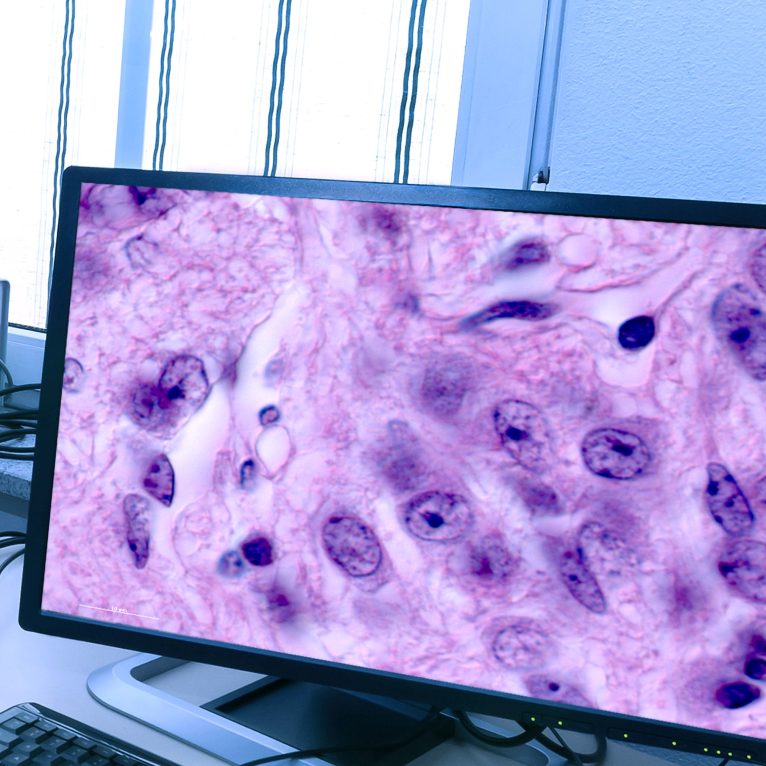
Written by

Cranfield, UK, 13th November 2023 – Another year celebrating a sold-out exhibition and attendee register, and Pathology Visions 2023 is now over. After speaking to >40 vendors at the show and attending multiple talks and presentations, Signify Research’s Imogen Fitt shares her thoughts below on what the conference’s discourse revealed about the digital pathology industry’s future…
This year’s Pathology Visions was busier than ever, with multiple presentations from vendors, academics and regulatory authorities that helped shed light on the various nuances of the digital pathology industry.
After taking a tour through Halloween Town we at Signify Research spent time connecting with industry stakeholders and discussing the future of the digital pathology market; below are our thoughts on some of the recurring themes.
Interoperability & Partnerships Take Centre Stage
Pathology Visions is not just an opportunity for vendors to meet new customers, but it also acts as a great stage to announce, initiate, and develop business-to-business relationships, with many vendors reporting an even mixture of the two types of meetings throughout the event.
There’s been many partnerships for digital pathology vendors within and outside of pathology recently, with many more expected near-term. For both industry and customers, it can be difficult to cut through the noise of these announcements and ascertain which will result in significant commercial momentum.
Inter-disciplinary partnerships are often easy enough to evaluate on the surface, but the drive for interoperability has pushed many vendors towards outwardly proving their commitment to interoperability through announcing a series of intra-pathology business partnerships. These were originally impactful for the industry at a time when proprietary standards resulted in vendor ‘lock-in’. However, more recently as scanner vendors have moved towards embracing the DICOM standard and are now openly collaborating with third party software, it’s become a virtual guarantee that any vendor will be willing to integrate with third parties at the behest of its customers.
To this end, partnerships showcasing integration between singular businesses will soon start to evolve. End-to-end solutions between multiple vendors appear to have been becoming more common, but it’s still unclear how much value these provide.
Customers today want to implement and scale their digital pathology workflows with as much ease as possible, and no pathologist wants to go digital only to learn that all the value they were promised is effectively negated via user burnout. Promises of interoperability must be followed with serious investment in deep integration, and for this reason, in the future the discussion will increasingly begin to focus on managing and measuring how well labs can achieve interoperability between different systems.
A recent example of this would be Ibex Medical Analytics and Roche announcing the culmination of their collaboration to deeply embed Ibex’s algorithms into Roche’s IMS platform. The inception of this partnership was first announced years ago, showcasing how this was no easy commitment by the two companies. However, as we’ve outlined in previous insights, digital pathology usage will only increase in the coming years, and as it does users will start to demand embedded algorithms and a more seamless workflow. ‘Zero Click’ integrations will start to become more and more common, especially in high volume algorithms.
Alongside this, the desire in healthcare to simplify supply chains will result in certain vendors beginning to manage more logistical tasks relating to third party vendors. Paige’s AppLab™ is such an example where Paige has committed to allowing its users to browse, trial, purchase, and request additional applications through its marketplace. Whilst attracting partners and negotiating palatable business terms for multiple parties is no easy feat, as we’ve noted in our article on AI orchestration platforms, this will become much more common in the future as the number of vendors labs engage with increases.
AI Remains Front of Mind – But It’s One of Many Issues to be Ratified
Whilst clinical use of AI today is still relatively low, one of the key concerns for labs purchasing an IMS today revolves around a platform’s ability to facilitate access to third party AI algorithms. This reflects the significant interest the market has in adopting AI solutions, but also the significant concern customers have around “locking” themselves into a particular product.
In the US, so few products and algorithms are FDA cleared that clinical customers especially fear ‘wasting’ investment. For newcomers, digital pathology adoption can be arduous, with individual decisions required on pre-imaging workflow protocols, scanners, IMS, displays, AI algorithms and storage retention.
Because of this, certain products and processes are often prioritised over others, and spend can be skewed considerably. In certain markets there remains significant lack of clarity on several issues involved with digital pathology implementation, and this can contribute to a slow and complex adoption.
Regulatory discussions held during the conference offered hope to many, however it’s unlikely given the multitude of issues to tackle that worldwide regulation will be able to effectively put to bed all digital pathology unknowns anytime soon. Below is a table illustrating some of the barriers present in the US market.
 Table 1: Barriers to Digital Pathology Adoption in the US Market Today
Table 1: Barriers to Digital Pathology Adoption in the US Market Today
There is further progress to come, however. Many vendors are currently seeking regulatory approval and many new ones will submit applications over the next few months. Increasingly studies and economic models are being published that show the return on investment for labs that seek to adopt both digital pathology and digital pathology AI products.
For now, because of these issues and the nascent nature of the market, the incentive for labs to go fully digital is unclear. But should labs aim for 100% digitisation right off the bat? Benefits for providers in adopting digital pathology will differ considerably, as shown in Figure 1. Vendors are slowly starting to steer customers towards more tailored adoption and implementation, supporting labs in asking critical questions such as: what can I do now to transition to digital workflows that will benefit me tomorrow?
 Figure 1: Benefits in adopting digital pathology for providers.
Figure 1: Benefits in adopting digital pathology for providers.
Whilst impressive growth is being achieved in both clinical and research settings, a large part of the market remains a greenfield opportunity. We are in the early adopter phase of digital pathology investment, and labs face many unknowns when embarking on this journey. As the market evolves and digital pathology penetrates more deeply into practice, customer demands and priorities will also evolve; however, for now we should not be forcing 100% adoption when an abundance of clarity and guidance is needed.
Key Takeaways
In our ‘Pathology Visions Show Report’ Signify Research will examine each of the vendor announcements made during and around the show, providing an in-depth analysis for each with market context. Trends like DICOM adoption, interoperability and real-world data innovations will be discussed at length so if you would like to know more about these click here.
Our key takeaways from the conference however can be summarised with the following:
- Integration and Interoperability are one of the most crucial factors impacting digitisation today. Chiefly, integration between laboratory information systems and pathology image management software should be as deeply integrated as possible to create an intuitive workflow for users. Pathologists who have access to this kind of workflow are often the ones who will be able to benefit the most from digitisation.
- Similarly, AI adoption is coming; however, labs will seek to streamline supply chains through IMS and scanner providers. Consolidation is coming not only in the form of vendor mergers, acquisitions and exits, but also through partnerships, deeper integrations and streamlined routes to market.
- Digital Pathology has many significant challenges that lie ahead, however new interest is plentiful, and the market opportunity is strong. More guidance should be provided on best practices through case studies and published success stories.
The reality behind digital pathology is that many labs are digitising and facing a multitude of unfamiliar problems to overcome, and it can be overwhelming at first. However, whilst the industry has a long way to go, significant steps forward are being made at every turn. There is a balance between considering a market’s needs today and planning for the future, and attending these conferences is one of the best ways to take the pulse of an industry.
Speaking with Matthew Hanna, co-chair at the Digital Pathology Association, he stated:
“Igniting digital pathology transformation was the theme of this year’s conference, and this year we’ve welcome a significant number of new attendees, further showing that the field has reached a critical mass for change. Pathology Visions serves as a melting pot between industry, academic, medical, and regulatory professionals, with increasingly administrative representation showcasing clinical practices’ readiness for innovation. Real tools and technologies are emerging from industry to help patients and pathologists, promising a profound evolution for pathologists.”
– Matthew Hanna, MD, Memorial Sloan Kettering Cancer Center
So, what is behind the ‘pulse’ of digital pathology today? I’d argue it’s mostly excitement, enthusiasm, and the energy to overcome some of the challenges ahead.
Related Research
Digital Pathology Market Intelligence Service – World – 2023
Signify Research’s Market Intelligence Service provides a rolling 12-month coverage of the global Digital Pathology market. The service is composed of four deliverables, as shown below.
 This core market update, the first of four publications included as a part of the service, builds upon five years of previous research, and will enable you to:
This core market update, the first of four publications included as a part of the service, builds upon five years of previous research, and will enable you to:
- Inform product investment and business strategy
- Evaluate the ever-changing competitive landscape to assess the impact of associations and select potential partners
- Acquire a holistic view of the nuances between different pathology research and clinical markets
- Understand adjacent markets such as enterprise imaging, laboratory information systems and the influence these will have on Digital Pathology
For any further questions, or samples of the service contents, please contact the Imogen Fitt, the report author.
About Imogen Fitt
Imogen joined Signify in 2018 as part of the Healthcare IT team. She holds a 1st class Biomedical Sciences degree from the University of Warwick where her studies included molecular biology and pharmacology. Since joining the team Imogen has studied the medical imaging software and hardware markets and is now expanding Signify Research’s Diagnostics and Lifesciences coverage.
About the Diagnostics and Lifesciences Team
The Diagnostics and Lifesciences team provides market intelligence and detailed insights on the multiple healthcare technology markets where the clinical world intersects with the preclinical. Our areas of coverage include digital pathology, laboratory information systems, clinical Real-World Data (cRWD) platforms, oncology information systems, tumour board software, oncology decision support software and radiotherapy IT. Each report provides a data-centric and global outlook of its markets with granular country-level insights. Our research process blends primary data collected from in-depth interviews with healthcare professionals and technology vendors, to provide a balanced and objective view of the market.
About Signify Research
Signify Research provides healthtech market intelligence powered by data that you can trust. We blend insights collected from in-depth interviews with technology vendors and healthcare professionals with sales data reported to us by leading vendors to provide a complete and balanced view of the market trends. Our coverage areas are Medical Imaging, Clinical Care, Digital Health, Diagnostic and Lifesciences and Healthcare IT.
Clients worldwide rely on direct access to our expert Analysts for their opinions on the latest market trends and developments. Our market analysis reports and subscriptions provide data-driven insights which business leaders use to guide strategic decisions. We also offer custom research services for clients who need information that can’t be obtained from our off-the-shelf research products or who require market intelligence tailored to their specific needs.
More Information
To find out more:
E: enquiries@signifyresearch.net
T: +44 (0) 1234 986111
www.signifyresearch.net
